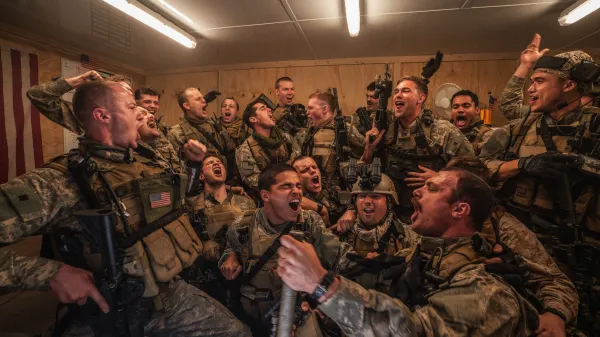
Told solely through the compiled memories of those who experienced it, Warfare documents a single, real-life military operation on November 19, 2006 in Ramadi, Iraq. The 1-26 infantry, Bravo Company “Bushmasters” platoon of Navy SEALs embark upon a mission through insurgent territory during the final stages of the Battle of Ramadi. After the mission goes awry, it’s up to them to escape with as few casualties as possible.
When choosing to embark upon this project following the release of last year’s Civil War, Garland stated that he wished to create a realtime retelling of a true story at the identical cadence and rhythm of an actual military firefight. He and Mendoza have managed to make Garland’s concept come to fruition completely, creating a fully immersive cinematic experience that allows the audience to feel as if they’re directly embedded within the Bravo company and experiencing the visceral brutality of war without actually being physically present. The filmmakers achieve this firstly through the film’s visuals, starting with the camera work in the opening scene where audience is moved alongside the soldiers as they clear a two-story home in preparation for building a sniper’s nest and observation station. It provides viewers with a side-by-side vantage point with the infantry as they do their work. The result is an experience that seems like the closest one can get to an almost 3-D movie experience that feels as if it places you directly within the scene without requiring the use of 3-D glasses.
The second way that Warfare utilizes the technical side of filmmaking in creating a sense of immersion is its magnificent use of sound. The film’s sound design is used to both communicate soldiers’ mind state and the physical aspect of warfare that they experience, sharing it with the audience through a sensory experience best experienced in a premium theater setting. The internal thoughts and muffled sounds soldiers have during shell shock is perfectly displayed through pitch utilizing IMAX or Dolby speakers, so that audiences feel it alongside the characters in addition to witnessing it onscreen. It makes the experience that much more real and results in something that is as empathetic as it is visceral for the audience. That authenticity is what makes Warfare a powerful commentary on what war is without having to empathize any message or plot devices and instead relying on feel and the recreation of physical experiences.
The film also underscores the reality of who soldiers are by effectively interspersing moments of levity within the tenseness and seriousness of the life or death mission at hand. As incredibly as Garland and Mendoza build tension in this film and make the audience feel dreadful that anything can happen at moment’s notice, that the soldiers can still rib each other and joke around at times makes the point that these warriors are just regular guys thrust into dangerous situations and environments. Providing a glimpse into their personalities and displaying their reactions to the brutal realities of combat humanizes the soldiers and brings them down to a level past mythical warriors and into young men who have immense responsibility foisted upon them and respond as best they can. In doing so, the brutality of what they face and what the audience witnesses is given the proper weight and its effects made that much more real.
What results is one of the best war films ever made because of the stark realism presented and the depiction of whom war affects and how heavy said effects are. Warfare is careful to offer a “ Just the facts, ma’am” perspective on the Battle of Ramadi and war in general. No editorializing or moral or ethical judgements, just combat in its rawest form where the real life consequences are made so clear and plain that regardless of your threshold for conflict, the ugliness of the results are made plain to all. War is hell.
Image: A24

